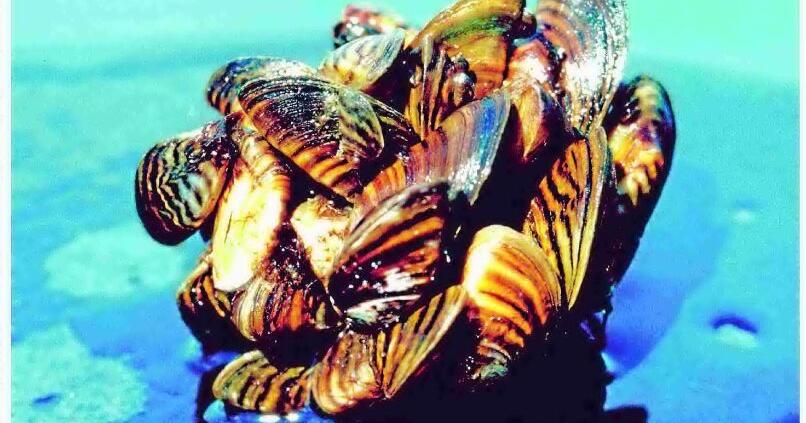Cleaning your fishing equipment with hot water could save Montana millions of dollars, according to Montana Fish, Wildlife and Parks officials.
Tayler Templin, Northwest Area AIS supervisor for Montana Fish, Wildlife and Parks, briefed area residents on the dangers of invasive species and some of the ways that Montanans can avoid accidently assisting in their invasion at an informational meeting at the Elk’s Lodge in Hamilton hosted by Bitterroot Trout Unlimited on Thursday night.
“There’s a lot going on regionally with AIS,” Templin said. “I’m sure some of you know that in 2023 there was a mussel detection in the Snake River, which is the first time mussels have been detected in the Columbia River basin.”
A small number of quagga mussels were discovered in the Snake River in September of 2023, according to the Idaho State Department of Agriculture. Mussels are considered one of the most insidious invasive species by Montana Fish, Wildlife and Parks because of their incredible resilience and pervasive nature.
People are also reading…
“Huge deal,” Templin said. “Mussels are kind of the poster child for AIS and so that’s where we spend a lot of our focus.”
Quagga and zebra mussels are particularly dangerous invasive species because of their large population sizes that can spread like blankets over lake beds, ingesting disproportionate amounts of water nutrients and clogging man-made water intakes.
“It’s better to keep mussels out of our systems because right now our programs cost $3 million a year,” Templin said. “If we got mussels into Montana waters, it would cost about $26 million a year to take care of and implement mitigation.”
Invasive mussel species, like the quagga and zebra, have already infiltrated numerous large bodies of water within the U.S.
Zebra mussels, which are indigenous to Ukraine, spread in the Great Lakes in the 1980s after hitching rides on the hulls of European ships, according to USGS.
After becoming acquainted with the Great Lakes region, zebra mussels quickly spread and now inhabit areas in the eastern Mississippi river, as well as Utah, Texas, California, Nevada and Colorado.
“What we see a lot in Montana is boats coming back from Lake Havasu, Lake Powell, the Great Lakes area and that’s when we really find most of our mussels on boats,” Templin said.
Templin supervises the Montana Fish, Wildlife and Parks’ watercraft inspection stations, which are scattered around the state to ensure that contaminated boats are, hopefully, caught and sufficiently cleansed before they spread invasive species.
Templin suggested that Montanans who plan to transport their boat to and from an out-of-state body of water, save themselves and the Montana Fish, Wildlife and Parks the hassle by just renting a boat.
“It’s gonna be much easier on you in the long term,” Templin said. “When you come back to Montana and we find mussels on that boat, which is very likely, we lock it for a minimum of 30 days and that can go up to two months.”
Another important thing Montanans can do to prevent the spread of other AIS, like the New Zealand mud snail, is to make sure they’re adequately sanitizing their equipment, Templin said.
“I think it’s really important that we all clean, drain and dry our equipment between every use,” Templin said. “I tell my staff every year, ‘If you are not sick of saying clean, drain, dry, you’re not saying it enough.'”
The New Zealand mud snail is an incredibly invasive aquatic species that was detected in a private hatchery in the Bitterroot within the last five years. New Zealand mud snails are usually about the size of a grain of rice and can rapidly reproduce; one mud snail asexually produces around 230 off spring a year.
“It doesn’t take much to spray off your waders or your boots. Just to make sure we’re not spreading that from place to place,” Templin said.
Templin said that mussels, mud snails and “really anything” within the realm of invasive species can be cleaned off of equipment by just using hot water.
“From a department standpoint, we use hot water, that’s all we use. We don’t use any chemicals. We just use water anywhere from 120 to 140 degrees,” Templin said.
Some other sanitation procedures suggested by the Pennsylvania Fish and Boat Commission include, “Freezing gear for a minimum of six hours. Soaking gear in hot (>120 Fahrenheit) water for at least five minutes. Drying gear completely for at least 5 days.” Templin said that the potential threat of AIS is always there and that Montanans should actively be trying to protect and preserve our waters as best they can.
“There’s always a potential,” Templin said. “We as a department, we as an agency, we as a program can only do so much and the rest of that falls on all of you to make sure that you clean, drain and dry before you go from one water body to another.”
Jackson Kimball is the local government reporter for the Ravalli Republic.





